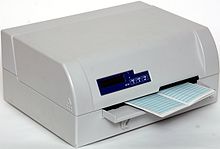
Back ዶት ማትሪክስ ፕሪንተር Amharic طباعة نقطية Arabic Матричен принтер Bulgarian Impressora matricial Catalan Jehličková tiskárna Czech Matrixprinter Danish Matrixdrucker German Εκτυπωτής μήτρας Greek Impresora matricial Spanish Inprimagailu matrizial Basque


Dot matrix printing,[1] sometimes called impact matrix printing, is a computer printing process in which ink is applied to a surface using a relatively low-resolution dot matrix for layout. Dot matrix printers are a type of impact printer that prints using a fixed number of pins or wires[2][3] and typically use a print head that moves back and forth or in an up-and-down motion on the page and prints by impact, striking an ink-soaked cloth ribbon against the paper. They were also known as serial dot matrix printers.[4] Unlike typewriters or line printers that use a similar print mechanism, a dot matrix printer can print arbitrary patterns and not just specific characters.
The perceived quality of dot matrix printers depends on the vertical and horizontal resolution and the ability of the printer to overlap adjacent dots. 9-pin and 24-pin are common; this specifies the number of pins in a specific vertically aligned space. With 24-pin printers, the horizontal movement can slightly overlap dots, producing visually superior output (near letter quality or NLQ), usually at the cost of speed.

Dot matrix printing is typically distinguished from non-impact methods, such as inkjet, thermal, or laser printing, which also use a bitmap to represent the printed work. These other technologies can support higher dot resolutions and print more quickly, with less noise. Unlike other technologies, impact printers can print on multi-part forms, allowing multiple copies to be made simultaneously, often on paper of different colors.[5] It can also employ endless printing using continuous paper fanfolded with perforations for each page to be easily torn from each other.
- ^ Peter H. Lewis (December 17, 1985). "Getting the most out of a dox matrix printer". The New York Times. Archived from the original on December 12, 2017. Retrieved December 12, 2017.
- ^ "Dot-matrix printer". Britannica.com. Archived from the original on 2017-12-12. Retrieved 2017-12-12.
- ^ Peter H. Lewis (December 17, 1985). "Getting the most out of a dot matrix printer". The New York Times. Archived from the original on December 12, 2017. Retrieved December 12, 2017.
- ^ "Dot Matrix Printer". PCmag.com. Ziff Davis. Archived from the original on 2017-12-12. Retrieved 2017-12-12.
- ^ "Dot Matrix vs. Inkjet". YourBusiness.AZcentral.com. Archived from the original on 2019-10-12. Retrieved 2018-10-17.
Dot matrix and inkjet printers share one key characteristic — both make images out of small dots. With a dot matrix printer, a pin presses through a ribbon to make an impact on the page. Inkjet printers have an electrical signal that causes a microscopic quantity of ink to squirt onto the page.
© MMXXIII Rich X Search. We shall prevail. All rights reserved. Rich X Search